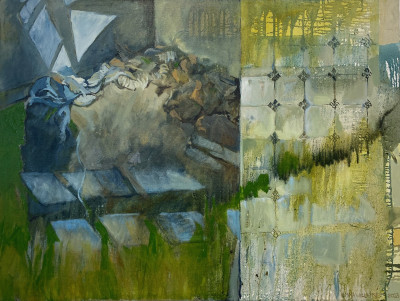Imagined tales of Molyvos

Imagined Tales of Molyvos
2022
Artist statement
I visited the small and ancient town Molyvos, on the island Lesbos in Greece, in October 2022. Molyvos is situated on a rocky hill, overlooking the Aegean Sea with the shores of Turkey visible in the distance. From the castle, built during the Byzantine period, the narrow-cobbled roads slope down to the small harbour, winding through three thousand years of history embedded under the streets and traditional homes built from stone and wood.
Wall segments of the wall around the Castle of Molyvos
The town is steeped in history, myths, legends and stories – even the name Molyvos has a mythical origin: it is named after Methymna, the daughter of the mythical king Macar. My engagement with locals confirmed the proliferation of stories connected to the place, as conversations around a long table in the evenings produced a wealth of these - from a naïve painter who lived in a tree and nearly exhibited in the Louvre to a scarlet woman cast out by society who publicly committed suicide by setting herself on fire sitting on her favourite chair.
The serenity of today’s Molyvos belies the events in its history related to the subjugation and displacement of people. Some of these include the aftermath of the conquest of the Ottomans in 1462, when a large part of the inhabitants of Lesbos were carried off as slaves, as servants in the Sultan’s palace or to help repopulate Constantinople. During World War I and its aftermath, an organised genocide of Ottoman Greeks took place in Turkey on the basis of their religion and ethnicity, which led to the fleeing of refugees and survivors back to their homeland, adding over a quarter to the prior population of Greece. In recent years the Mediterranean refugee crisis saw about 800 000 people fleeing war and poverty, mainly from Syria, crossing the narrow straight between Turkey and Lesbos, arriving at a small beach just outside Molyvos.
These major events in history paint the background for countless layers of personal stories of lives lived in Molyvos, passed on from generation to generation. Even though some stories are forgotten, intentionally repressed or untold, they are nevertheless still present, stacked through time, they become inscribed in the physicality of the place. The physical evidence of events that shaped the lives of Molyvos’ citizens is recognizable in the overlooked details embedded in stone walls, the traces left behind in an abandoned hotel, the patina and stains left behind on surfaces, the discarded fragments of man-made objects and materials.
My investigation at Molyvos entailed the documentation of these overlooked details in an effort to excavate the layers of remnants of lives lived, as well as to partially reveal the stories connected to it. True to the nature of remnants, the findings are inevitably incomplete.
My intention was to suggest a multiplicity of possible narratives. By augmenting the singular photographic documents with juxtaposition, digital layering and excavation techniques, I attempted to allude to the complexity of personal and intimate stories that are retold through a subjective lens – stories that become exaggerated, fantasised and imagined.






